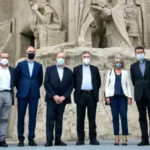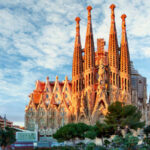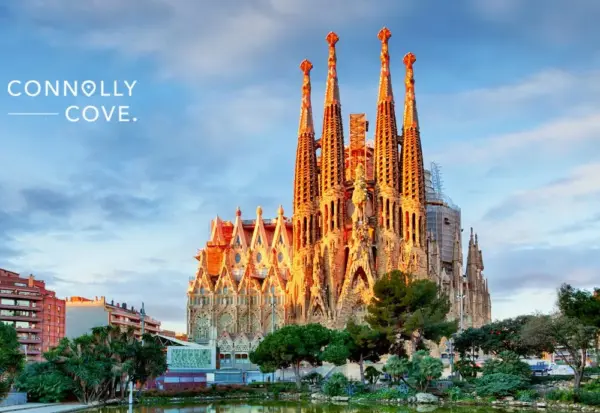
The Sagrada Família, an iconic symbol of Barcelona, stands as a testament to Gaudí's genius and vision. Its intricate facades and soaring towers invite thousands of visitors each year, eager to experience the beauty and spirituality infused in every corner of this monumental basilica.
Within its walls lies a world of artistic wonders and architectural innovations, making it a must-visit destination for anyone captivated by design and history. As we delve into **Exploring the Wonders Inside Sagrada Família: Barcelona's Architectural Marvel**, we will uncover the stories and inspirations that shaped this extraordinary masterpiece.
The Unique Architectural Features of Sagrada Família: A Closer Look
The architectural brilliance of the Sagrada Família can be seen in its distinctive facades, each telling a unique story. The Nativity Facade, for example, celebrates the birth of Christ, adorned with intricate sculptures that depict nature and life. In contrast, the Passion Facade presents a more austere and dramatic representation, symbolizing sacrifice and redemption through its stark, angular forms.
One of the most striking features of this basilica is its hyperboloid structures. These architectural elements create a sense of upward movement, drawing the eye towards the heavens. The use of natural light is another hallmark of Gaudí's design, with stained glass windows casting vibrant colors across the interior, illuminating the space in a dance of light and shadow.
Furthermore, the columns inside Sagrada Família are designed to resemble trees, branching out to support the ceiling. This unique approach not only enhances the visual appeal but also serves a structural purpose, allowing for greater height and stability. The integration of natural forms into the architecture reflects Gaudí's deep admiration for nature and organic shapes.
- Innovative Use of Geometry: Gaudí employed complex geometric shapes, contributing to the basilica's stunning visual dynamics.
- Symbolism in Design: Every element, from the columns to the facades, is rich in meaning and reflects the Christian faith.
- Environmental Harmony: The design harmonizes with its surroundings, emphasizing the connection between architecture and nature.
Understanding the Symbolism Behind Sagrada Família's Design
Understanding the symbolism behind the design of Sagrada Família reveals the profound spirituality woven into every aspect of Gaudí's work. The basilica serves as a representation of the Christian faith, where each facade and structure is imbued with meaning. For instance, the Nativity Facade symbolizes the birth of Christ, richly decorated with elements that represent creation and divine love, while the Passion Facade starkly portrays the suffering of Jesus, embodying themes of sacrifice and salvation.
Gaudí's use of natural forms further enhances the symbolism of Sagrada Família. The columns, designed to mimic trees, not only support the structure but also symbolize the connection between heaven and earth. This organic approach reflects the idea that nature is a manifestation of the divine, reinforcing the spiritual journey that the basilica seeks to represent. Each column acts as a reminder of the sacredness of life and the importance of nurturing the environment.
Moreover, the intricate details found throughout the basilica, such as the stained glass windows, serve a dual purpose. They not only illuminate the interior with colorful light but also depict biblical narratives that invite contemplation and reflection. These visual stories engage visitors, encouraging them to explore the deeper meanings of faith and existence. The unique interplay of light and color symbolizes the divine presence, transforming the space into a spiritual sanctuary.
- Spiritual Journey: Each element guides visitors through a narrative of faith and devotion.
- Connection with Nature: The design emphasizes a harmonious relationship between architecture and the natural world.
- Complex Geometry: Symbolic shapes and patterns enhance the thematic depth of the basilica.
The History and Vision of Antoni Gaudí's Masterpiece
Antoni Gaudí's vision for the Sagrada Família was inspired by his deep religious beliefs and his passion for nature. Construction began in 1882 and has evolved over more than a century, reflecting Gaudí's innovative techniques and unique architectural style. Despite his death in 1926, the project continues to integrate modern technologies with Gaudí's original concepts, ensuring the basilica is a living testament to his genius.
The history of the Sagrada Família is entwined with the growth of Barcelona as a modern city. Initially commissioned by a bookseller, the basilica has transformed into a symbol of Catalan identity and artistic expression. As the project progressed, it attracted numerous architects and artisans who contributed to its development, each leaving their mark while adhering to Gaudí's original vision.
Among the numerous challenges faced throughout its construction, the impact of the Spanish Civil War led to significant delays and the loss of many original plans. Nevertheless, the dedication to completing Gaudí's masterpiece remains unwavering. Notable milestones include the completion of the Nativity Facade in 1936 and the ongoing work on the central towers, reflecting a blend of historical respect and modern craftsmanship.
- Gaudí's Legacy: Continues to inspire architects worldwide with his groundbreaking techniques.
- Unfinished Project: The Sagrada Família is expected to be completed by 2026, marking its 100th anniversary of Gaudí's death.
- Architectural Innovations: Incorporates advanced technologies such as 3D modeling and computer-aided design.
Exploring the Interior Wonders of Sagrada Família
Stepping inside the Sagrada Família is akin to entering a sacred forest, where nature and spirituality intertwine. The interior design, characterized by its towering columns resembling trees, creates a canopy effect that draws visitors into a peaceful realm. This organic architecture not only serves a structural role but also symbolizes the connection between the divine and the natural world, inviting contemplation on the beauty of creation.
The play of light and color within the basilica is extraordinary. The stained glass windows, crafted with meticulous detail, cast vibrant hues that dance across the interior, transforming the space into a living mosaic. Each window tells a biblical story, providing a visual narrative that enhances the spiritual atmosphere. As sunlight filters through, it creates an ethereal glow that changes with the time of day, reminding visitors of the ever-present connection to the divine.
Another remarkable aspect of the interior is its acoustic design, which allows for a harmonious blend of sound during services and performances. The unique geometrical shapes and materials used in construction contribute to an exceptional auditory experience, making the Sagrada Família not only a visual masterpiece but also a sonic one. This intentional integration of sound creates an immersive experience that resonates with the spiritual messages conveyed through the architecture.
- Nature-inspired Elements: The basilica's design reflects organic forms, reinforcing the connection between architecture and the environment.
- Illuminated Narratives: Stained glass windows depict significant biblical events, inviting deeper reflection.
- Acoustic Harmony: The interior's unique design enhances sound quality, enriching religious ceremonies.
Why Sagrada Família is a UNESCO World Heritage Site
The Sagrada Família was designated as a UNESCO World Heritage Site in 2005 due to its exceptional architectural value and its representation of the innovative genius of Antoni Gaudí. This masterpiece encapsulates the unique Catalan Modernisme style, blending Gothic and Art Nouveau elements in a way that has never been replicated. Its intricate designs and organic forms reflect Gaudí's deep connection with nature and spirituality, making it a cultural beacon in the heart of Barcelona.
Moreover, the basilica's construction, which began in 1882 and continues today, illustrates a significant evolution of architectural techniques. Gaudí's use of cutting-edge methods, such as hyperboloid structures and catenary arches, not only enhanced the aesthetic appeal but also pushed the boundaries of engineering. This innovative approach has set a precedent for modern architecture, further justifying its recognition as a UNESCO World Heritage Site.
The Sagrada Família also holds immense cultural and historical significance, symbolizing the identity of Barcelona and the Catalan people. Its ongoing construction, which incorporates both traditional craftsmanship and modern technology, represents a commitment to preserving Gaudí's vision while adapting to contemporary needs. This living monument serves as a testament to the enduring legacy of artistic and architectural excellence in the region.
Finally, the basilica's spiritual essence is integral to its status as a World Heritage Site. Each facet of the Sagrada Família is imbued with religious symbolism, inviting visitors to engage in a profound exploration of faith and devotion. The harmonious integration of natural light, intricate sculptures, and detailed stained glass windows transforms the space into a sanctuary, reinforcing its importance as a site of worship and reflection for people from around the globe.
Visitor Tips for Experiencing Sagrada Família in Barcelona
When planning your visit to the Sagrada Família, consider purchasing your tickets online in advance. This not only helps you avoid long queues but also guarantees your entry at a preferred time. Additionally, guided tours can provide deeper insights into Gaudí’s architectural genius and the basilica's rich history.
Timing your visit can significantly enhance your experience. Early morning or late afternoon visits tend to be less crowded, allowing for a more tranquil exploration of the interior. Another tip is to check the weather forecast before your visit, as sunny days can showcase the stunning effects of light streaming through the stained glass windows, enriching your overall experience.
- Dress Code: Remember that Sagrada Família is a place of worship, so dress modestly. Shoulders and knees should be covered.
- Photography: While photography is allowed, be respectful of others and avoid using flash during services.
- Audio Guides: Consider using an audio guide for a more informative visit, as it provides context and stories behind the basilica's features.
For those visiting with children, look for family-friendly activities that can make the trip enjoyable for all ages. Engaging the little ones with stories about Gaudí's life and the basilica’s symbolism can turn the visit into an educational adventure. Lastly, don’t forget to explore the surrounding area, where you can find parks and cafes perfect for a leisurely break after your visit.
 Sagrada Familia Barcelona Dress Code: What to Wear for Your Visit
Sagrada Familia Barcelona Dress Code: What to Wear for Your Visit Discover the Magnificent Sagrada Familia in Barcelona's Vibrant District | Barcelona Turisme
Discover the Magnificent Sagrada Familia in Barcelona's Vibrant District | Barcelona TurismeIf you want to know other articles similar to Exploring the Wonders Inside Sagrada Família: Barcelona's Architectural Marvel you can visit the category WHERE YOU CAN GO.
Leave a Reply










Read more!